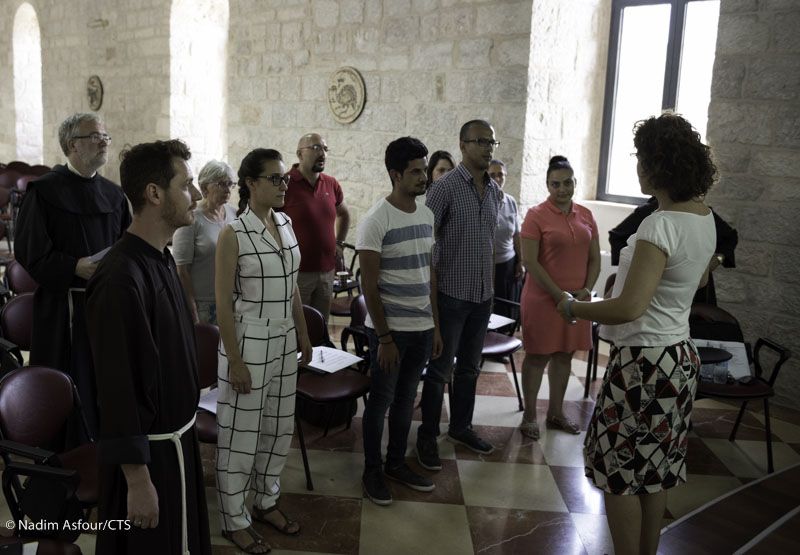In the Hall of the Immaculate One, a mixed group of people satisfies its curiosity with sheets full of music. The professor plays some arrangements on the piano and then explains the symbols written on the sheets. A moment later, the chanting begins: this is the first practical and theoretical course of Gregorian chant, organized by the Custody of the Holy Land in collaboration with the Magnificat Institute. In a few days of work (from July 4 to 8), Prof. Giulia Gabrielli has the mission of teaching her theoretical and practical knowledge about the art of singing related to liturgical celebrations. At St. Savior’s Monastery in Jerusalem, this is the first time that such an initiative has taken place.
“I participated in several Gregorian chant courses abroad,” Br. Aberto Pari, director of the Magnificat, the music institute of the Custody of the Holy Land, “and for this reason, I asked the Custos to send two or three friars a year to do the same. He spoke to me about the professor and the opportunity to invite her here to teach a course.” So it happened and the result seems like it was a success. “Approximately forty people are attending the courses. There is also the group of students who are hopeful to attend the seminary and for them the course will be very useful because they will sing for the Custody.” Gregorian chant, in fact, is acknowledged by the Catholic Church as “the very chant of the Roman liturgy” and it is used in almost every celebration carried out by the Franciscans in the holy places.
Prof. Giulia Gabrielli puts passion and patience into her slides about the history of chant and into the practical exercises [that she leads]. She is not new to teaching, being a teacher of music and musicology at the Free University of Bolzano.
“At the Custody we often sing Gregorian chant, and so we who participate in the Franciscan liturgy need more knowledge about this way of singing,” said a French volunteer working for the Custody’s Cultural Heritage Office. “The professor is very competent and the subject matter is interesting,” a friar from the Studium Biblicum Franciscanum, who was taking a break, exclaimed enthusiastically. Hector, who aspires to attend the seminary, said that they were advised to attend, but that he did not expect to like the course as much as he did. Next to him, one of the friar’s classmates explained that the theoretical lessons are also useful, since he believed that Gregorian chant came from St. Benedict: “In this way, I am learning to understand the true history of this chant.”
Fr. Alberto said, “As always happens the first few times, this first course is explorative. We split into two groups to chant, also because we realized the difference between beginners and those who are at an intermediate level. We have had many registrants and the course is going well,” said Prof. Gabrielli. “In the theoretical part, the birth of Gregorian chant, the history and issues related to the interpretation of the repertoire were addressed.” Gregorian chant was born in the Carolingian era (800-850 A.D.) from the fusion of two traditions. It existed beforehand, but every region, every diocese, every church had its own way of chanting. Carolingians, on the other hand, decided to make the liturgy uniform, blending the tradition of Roman chant with that of French song. Gregorian chant is in fact referred to as Franco-Roman chant.
There was ample room in the lessons for the practical portion [of the course], too, so that friars, laypeople and religious could learn to chant better. And so that [they can] sing Gregorian chant in the liturgies that take place in the holy places.
Beatrice Guarrera


